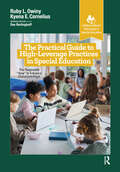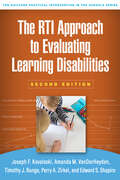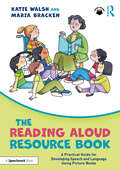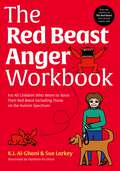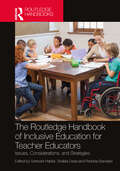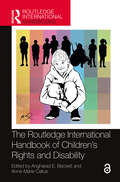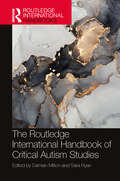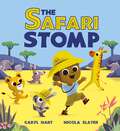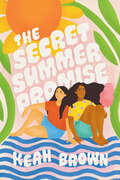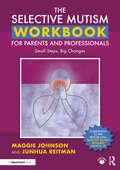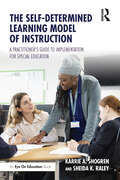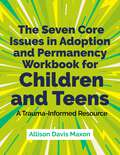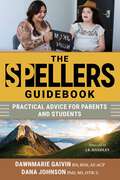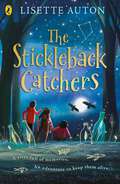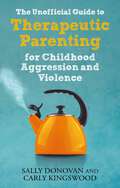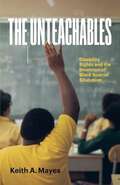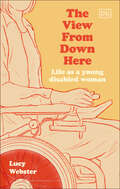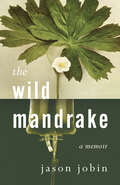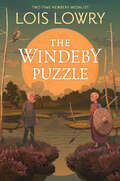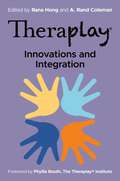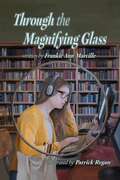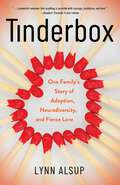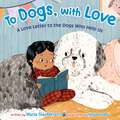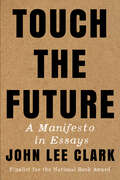- Table View
- List View
The Practical Guide to High-Leverage Practices in Special Education: The Purposeful “How” to Enhance Classroom Rigor (Evidence-Based Instruction in Special Education)
by Ruby L. Owiny Kyena CorneliusDesigned for teacher preparation programs as well as teacher professional development, The Practical Guide to High-Leverage Practices in Special Education: The Purposeful “How” to Enhance Classroom Rigor is the first book of its kind to introduce multiple HLPs working in tandem to implement evidence-based practices (EBPs).The Practical Guide to High-Leverage Practices in Special Education is a powerful tool for those dedicated to improving student outcomes. Planned with the practitioner in mind, the text’s main objective is for teachers to recognize EBPs as “what” they teach and HLPs as “how” they teach. The book is written with a focus on inclusive education, making it a valuable resource for both general and special educators.What’s included in The Practical Guide to High-Leverage Practices in Special Education: A focus on one HLP per chapter and descriptions of connected HLPs and how to use them for implementing featured EBPs Classroom scenarios for both elementary and secondary classrooms Tables of the crosswalks of connected HLPs and EBPs with resources forfurther learning The Practical Guide to High-Leverage Practices in Special Education: The Purposeful “How” to Enhance Classroom Rigor provides educators with the understanding of how HLPs and EBPs connect to effectively implement them for student success and is also an effective teaching and learning tool for teacher education preparation programs.
The RTI Approach to Evaluating Learning Disabilities (The Guilford Practical Intervention in the Schools Series)
by Edward S. Shapiro Amanda M. VanDerHeyden Joseph F. Kovaleski Timothy J. Runge Perry A. ZirkelFrom leading authorities, this indispensable work is now in a revised and expanded second edition, presenting state-of-the-art tools and procedures for practitioners. The book shows how to use response to intervention (RTI) to evaluate K–12 students for specific learning disabilities (SLD). The second edition gives increased attention to optimizing the instructional environment in the context of a multi-tiered system of supports (MTSS). Procedures are described for screening at-risk students; using RTI to intensify instruction in reading, writing, and math; identifying SLD; determining eligibility for special education; and planning individualized education programs. Case examples and pointers for practice are woven throughout. In a convenient large-size format, the book includes reproducible tools that can be downloaded and printed for repeated use. New to This Edition *Incorporates contemporary perspectives on SLD, upgraded procedures for implementing an MTSS, new approaches to measuring RTI, and enhancements in using classroom observations. *Chapter on best practices in academic screening, including important dos and don'ts. *Separate chapters on using RTI for reading, written expression, and mathematics. *Chapter on RTI and special education law, focusing on what practitioners need to know. This book is in The Guilford Practical Intervention in the Schools Series, edited by Sandra M. Chafouleas.
The Reading Aloud Resource Book: A Practical Guide for Developing Speech and Language Using Picture Books
by Katie Walsh Maria BrackenThis practical guide is the ideal tool for the busy practitioner or speech and language therapist to provide an effective, meaningful, and contextualised approach to language development using picture books. Drawing from up-to-date, evidence-based research, each chapter shows you how to get the most out of picture books to support language development, with a focus on the range of opportunities that reading aloud can bring. The guide offers a complete package to promote speech, language, and early literacy, and to enrich language comprehension, vocabulary, phonological awareness, and oral language – all by using books to provide a context for meaningful language learning. The resource also includes advice on how to develop intervention goals and outcome measures for reading aloud, with practical suggestions covering topics from creating a reading routine and book nooks, to encouraging reluctant readers and reading aloud challenges. Language skills are essential for academic, social and communication success and this reading aloud resource will be valuable reading for early year educators, primary teachers, and speech and language therapists working with young children aged 0-7.
The Red Beast Anger Workbook: For All Children Who Want to Tame Their Red Beast Including Those on the Autism Spectrum
by Kay Al-Ghani Sue LarkeyThis illustrated and interactive workbook will help children find ways to calm their Red Beast and learn how to prevent it from waking in the first place. Full of practical activities and illustrated examples, it supports the development of emotional and sensory regulation and provides coping mechanisms for children who experience intense emotional flooding or meltdowns as well.The workbook includes a helpful introduction for adults on the science of self-regulation, clear guidance on how to pace the learning and a wide range of activities such as scenarios to help children explore their anger, anger management plans, and exercises that encourage interoceptive awareness. It also addresses common causes of anger including perfectionism, winning and losing and discusses the importance of a positive attitude and using kind words in a child-friendly way.Join Danni and his friends and family as they explore the challenges they face from the Red Beast and how they overcome them.
The Routledge Handbook of Inclusive Education for Teacher Educators: Issues, Considerations, and Strategies
by Santoshi Halder, Shakila Dada and Rashida BanerjeeThis handbook provides foundational, conceptual, and practical knowledge and understanding of inclusive education and special needs education. It highlights the need for preparing special educators and teachers for inclusive classrooms to effectively cater to the needs of students with diverse needs in various low-, middle-, and high-income countries globally. It demonstrates various evidence-based and practice-based strategies required to create classrooms inclusive of diverse learners. While tracing the historical trajectory of the foundational underpinnings, philosophical bases, and crucial issues associated with inclusive education, this book presents a future roadmap and pathways through case instances and in-depth discussions to share with educators how they can strengthen their bases and make learning more inclusive in their context. It also provides an overview of the different models of assessment and their applications in the analysis of children in inclusive classroom settings. Comprehensive, accessible, and nuanced, this handbook will be of immense interest and benefit to teachers, educators, special educators, students, scholars, and researchers in the areas of social inclusion, education, special needs education, educational psychology, technology for inclusion, disability studies, among other related disciplines. It will be extremely beneficial for academicians, teacher educators, special educators, and those interested in professional teacher training courses.
The Routledge International Handbook of Children's Rights and Disability (Routledge International Handbooks)
by Angharad E. Beckett Anne-Marie CallusThis handbook provides authoritative and cutting-edge analyses of various aspects of the rights and lives of disabled children around the world. Taking the UN Convention on the Rights of Persons with Disabilities (CRPD) and the UN Convention of the Rights of the Child (CRC) as conceptual frameworks, this work appraises the current state of affairs concerning the rights of disabled children across different stages of childhood, different life domains, and different socio-cultural contexts. The book is divided into four sections: Legislation and Policy Children’s Voice The Life Course in Childhood Life Domains in Childhood Comprised of 37 newly commissioned chapters featuring analyses of UN documents and case studies from Australia, Brazil, Ethiopia, Hong Kong, Italy, the Netherlands, Norway, Papua New Guinea, Serbia, South Africa, Spain, Sweden, the United Kingdom, the United States, and Vanuatu, its multidisciplinary approach reflects the complexities of the lives of disabled children and the multifarious nature of the strategies needed to ensure their rights are upheld. It will be of interest to researchers and students working in disability studies, education, allied health, law, philosophy, play studies, social policy, and the sociology of childhood. It will also be a valuable resource for professionals/practitioners, allowing them to consider future directions for ensuring that disabled children’s rights are realised and their well-being and dignity are assured.
The Routledge International Handbook of Critical Autism Studies (Routledge International Handbooks)
by Damian Milton and Sara RyanThis handbook provides an authoritative and up-to-date overview of Critical Autism Studies and explores the different kinds of knowledges and their articulations, similarities, and differences across cultural contexts and key tensions within this subdiscipline. Critical Autism Studies is a developing area occupying an exciting space of development within learning and teaching in higher education. It has a strong trajectory within the autistic academic and advocate community in resistance and response to the persistence of autism retaining an identity as a genetic disorder of the brain. Divided into four parts • Conceptualising autism • Autistic identity • Community and culture • Practice and comprising 24 newly commissioned chapters written by academics and activists, it explores areas of education, Critical Race Theory, domestic violence and abuse, sexuality, biopolitics, health, and social care practices. It will be of interest to all scholars and students of disability studies, sociology, anthropology, cultural studies, education, health, social care, and political science.
The Safari Stomp
by Caryl HartPrepare to hop, crawl, lunge and STOMP in this delightful rhyming story that will get children reading along and moving along!As I was going for a walk, I met a little Bunny."Come hop with me", the Bunny said,"Hopping's super funny!"Join the romp, join the romp,Let's hop to the wild safari stomp!Learn to move like your animal friends on safari! Lunge with a giraffe, roar with a lion and stomp, stomp, stomp with the elephants. On the safari stomp, everyone must join in the fun! With 5 different exercises to try and a brilliant rhyming refrain throughout, this story will have children reading along and moving along! From award-winning creators Caryl Hart and Nicola Slater.
The Secret Summer Promise
by Keah BrownTHE BSE (Best Summer Ever) LIST!1. Blueberries2. Art show in ShoeHorn3. Lizzo concert4. Thrift shop pop-up5. Skinny Dipping at the lake house6. Amusement Park Day!7. Drew Barrymarathon8. Paintball dayOh, and ….9. Fall out of love with HaileeAndrea Williams has got this. The Best Summer Ever. Two summers ago, she spent all her time in bed, recovering from the latest surgery for her cerebral palsy. She's waited too long for adventure and thrills to enter her life. Together with her crew of ride-or-die friends, and the best parents anyone could ask for (just don't tell them that), she's going to live it up.There's just one thing that could ruin it: Her best friend, Hailee, finding out Andrea's true feelings. So Andrea WILL fall out of love with Hailee – even if it means dating the cute boy George who keeps showing up everywhere with a smile.Do we want Andrea to succeed? No! Does she? We're not telling!Keah Brown is a journalist, screenwriter, and author who has written for places such as Teen Vogue, Elle, Harper's Bazaar, and the New York Times. She is also the creator of #DisabledAndCute. Now, in her YA debut of nerdy queer love, Keah gives us the perfect summer read and cast of characters to fall in love with.
The Selective Mutism Workbook for Parents and Professionals: Small Steps, Big Changes
by Maggie Johnson Junhua ReitmanThis workbook provides hands-on Activities, Strategies, planning sheets and progress trackers for use with children with selective mutism at home, at school and in the wider community. Written by selective mutism expert Maggie Johnson and parent coach Junhua Reitman, the workbook includes first-hand accounts of how children can overcome SM successfully using the Activities and Strategies described in this book. Activities are organised around the daily routines of school and family life and each Activity is broken into a progression of small steps with appropriate Strategies and an accompanying record sheet to track progress. Activities include: • Using the toilet at school • Attending social gatherings • Organising a successful playdate • Initiating conversation • Talking in the classroom • Eating with peers This workbook is essential reading for parents, professionals and anyone who is looking for a toolkit for selective mutism. It also provides a useful extension to The Selective Mutism Resource Manual, 2nd edition, focusing on the ‘how’ to complement the manual’s ‘what’ and ‘why’. Small steps really do lead to big changes but taking the first step can be the most difficult. This book helps you make that first step.
The Self-Determined Learning Model of Instruction: A Practitioner’s Guide to Implementation for Special Education
by Karrie A. Shogren Sheida K. RaleyThis practical guide introduces the Self-Determined Learning Model of Instruction (SDLMI), an evidence-based practice designed to promote student self-determination and support educators in enabling students to set goals, create action plans to achieve those goals, and self-evaluate their progress. Chapters explore integration with Multi-Tiered Systems of Supports and culturally sustaining implementation of the SDLMI. Hands-on tools for using the SDLMI to support students engaging in academic learning, transition planning, and community-based activities are provided. This guide also features stories from self-advocate SDLMI researchers and teachers highlighting how the SDLMI can be put in practice. Clear and comprehensive, this book is an essential resource for every educator.
The Seven Core Issues in Adoption and Permanency Workbook for Children and Teens: A Trauma-Informed Resource
by Allison Davis MaxonBased on the pioneering Seven Core Issues model, this resource is an accessible and age-appropriate way to support children and teens who have experienced early adversity, to strengthen understanding and healing. The Seven Core Issues are Loss, Rejection, Shame/Guilt, Grief, Identity, Intimacy and Mastery/Control. This resource combines two separate interactive workbooks - one for children developmentally aged 5-11, the other for children developmentally aged 12+. These can be filled in, photocopied or downloaded and provide a structured way for children and teens to explore their feelings and beliefs using exercises and activities. An ideal accompaniment to the Seven Core Issues Workbook for Parents of Traumatized Children and Teens, this resource will be valued by all adults supporting children who have experienced early adversity.
The Spellers Guidebook: Practical Advice for Parents and Students
by Dana Johnson Dawnmarie GaivinA means by which thousands, and soon millions, of people are being freed from their lives of silence. The Spellers Guidebook is the first of its kind—a comprehensive guidebook that every family should take along for their Spelling journey. From the moment you first learn about spelled communication through working with a practitioner, developing fluency, and everything in between, this book serves as a blueprint to follow while you build the skills to spell openly with your child. The Spellers Guidebook is informative not only for parents and caregivers but for practitioners and professionals as well. It answers questions from the most basic—what to expect during the first spelling session, to more clinical—what is apraxia, and how does it affect my speller? It even discusses the importance of regulation and how the interpersonal dynamic between the speller and their communication partner can impact flow. The journey toward open communication differs for every family, and this handbook is here to help remove any guesswork. Whether your path seems straight and easy to navigate or the road ahead appears winding and twisting, Dana and DM are here to guide you. If you walk away with nothing more than the confidence that you can do this with your nonspeaker (because you CAN), The Spellers Guidebook has done its job!
The Stickleback Catchers
by Lisette Auton'A magic realist fight to save a beloved grandmother from dementia . . . dialect, disability, neurodivergence and gender-nonconformity were all woven incidentally into this open-hearted book - Guardian Best Children's Books of 2023Mimi adores her wild, fun, full-of-life gran. Then Gran starts forgetting things. Suddenly there are cracks appearing all around their home - and a mysterious black crow - both of which only Mimi seems able to see.Mimi is determined to solve the mystery. Luckily she has new friends to help: Titch and Nusrat. Together, they're the Stickleback Catchers: solvers of puzzles and seekers of adventure.Down by the river, where the gang meet and the silvery sticklebacks swim, they discover a mysterious stone, speckled with stars. But this is no ordinary stone: it's the doorway to another world, a world of talking crows and secrets, magical constellations and memories - and maybe, just maybe, Mimi's chance to bring back Gran forever...
The Strengths-Based Guide to Supporting Autistic Children: A Positive Psychology Approach to Parenting
by Claire O'Neill'Being strength-aware has brought many moments of joy to our family life. It is this potential for growth and joy that I now want to share in this book'This flexible, dip-in-dip-out guide will introduce you to the strengths-based approach that is helping autistic children and their families to thrive. By focusing on how to identify, develop and use your child's strengths to support them throughout childhood and into adolescence, this transformative approach is here to show you and your child that their unique character-strengths can empower them and shape their future.Claire O'Neill combines her personal experience as an autistic person and mother to autistic children with her expert knowledge as a professional working with autistic young people to demonstrate the value of a strengths-based approach.With step-by-step instructions on how parents and teachers can incorporate this approach easily into family and school life, Claire also offers a variety of specific tips, tricks and engaging activities to provide ongoing support for parents and teachers alike.
The Unofficial Guide to Therapeutic Parenting for Childhood Aggression and Violence
by Sally Donovan Carly Kingswood"Parenting a distressed child puts us in an extraordinary situation, which demands extraordinary parenting."The reasons why distressed children may behave violently can be complex; this book sets out the biological, psychological, and environmental reasons as to why your child may be displaying violent behaviours and helps you develop strategies to reduce the incidence of violence, de-escalate violent situations and repair relationships following incidents. With the aid of this guide, develop a language to enable children to understand their emotional states in a safe environment. Expertly written by award-winning author, columnist and adoptive parent Sally Donovan and Dyadic Developmental Psychotherapist Carly Kingswood; learn how to care for yourself and the children in your lives.
The Unteachables: Disability Rights and the Invention of Black Special Education
by Keith A. MayesHow special education used disability labels to marginalize Black students in public schoolsThe Unteachables examines the overrepresentation of Black students in special education over the course of the twentieth century. As African American children integrated predominantly white schools, many were disproportionately labeled educable mentally retarded (EMR), learning disabled (LD), and emotionally behavioral disordered (EBD). Keith A. Mayes charts the evolution of disability categories and how these labels kept Black learners segregated in American classrooms.The civil rights and the educational disability rights movements, Mayes shows, have both collaborated and worked at cross-purposes since the beginning of school desegregation. Disability rights advocates built upon the opportunity provided by the civil rights movement to make claims about student invisibility at the level of intellectual and cognitive disabilities. Although special education ostensibly included children from all racial groups, educational disability rights advocates focused on the needs of white disabled students, while school systems used disability discourses to malign and marginalize Black students.From the 1940s to the present, social science researchers, policymakers, school administrators, and teachers have each contributed to the overrepresentation of Black students in special education. Excavating the deep-seated racism embedded in both the public school system and public policy, The Unteachables explores the discriminatory labeling of Black students, and how it indelibly contributed to special education disproportionality, to student discipline and push-out practices, and to the school-to-prison pipeline effect.
The View From Down Here: Life as a Young Disabled Woman
by Lucy WebsterA powerful, eye-opening insight into navigating the world as a disabled young woman Women&’s lives are shaped by sexism and expectations. Disabled people&’s lives are shaped by ableism and a complete lack of expectations. But what happens when you&’re subjected to both sets of rules? This powerful, honest, hilarious, and furious memoir from journalist and advocate Lucy Webster looks at life at the intersection: the struggles, the joys, and the unseen realities of being a disabled woman. From navigating the worlds of education and work, dating, and friendship to managing care, contemplating motherhood, and learning to accept your body against a pervasive narrative that it is somehow broken and in need of fixing, The View From Down Here shines a light on what it really means to move through theworld as a disabled woman.
The Wild Mandrake: A Memoir
by Jason JobinOn the cusp of adulthood, a young writer’s life is stalled as he faces cancer that keeps coming back.Doctors used to tell him he was cured. That was a long time ago. Ever since he first left home at age nineteen, writer Jason Jobin has had cancer. Every five years, like clockwork, it relapses, and yet he always pulls through, surrounded by friends and family but isolated by illness. Chemotherapy, surgeries, radiation — these persist, but they aren’t the milestones of his life. They can’t be, he won’t let them be.From helicoptering into the Yukon backcountry to teaching in an elite writing program, Jason strives to enter adulthood with some normalcy, but his is the life of “a special case.” And he does live. He lives working at a deli for minimum wage as his students come down the hill to shop and ask what he’s doing there. He lives measuring out nausea pills and benzos while his roommates drink and smoke and party. He lives lying to girlfriends about past diagnoses because what can you say? What do you build on rubble? He lives high and low and in between. Again he is sick, again he is cured. It’s miraculous. A great gift. But never enough.Told in short glimpses, this story redefines what it means to survive. Jobin brings together the illuminated moments of loss and joy as he navigates chronic illness and builds from it something new and wildly unexpected.
The Windeby Puzzle: History and Story
by Lois LowryNewbery Medalist and New York Times bestselling author Lois Lowry transports readers to an Iron Age world through the suspenseful dual narrative of a boy and girl both battling to survive. In an utterly one-of-a-kind blend of fiction and history, a master storyteller explores the mystery and life of the 2,000-year-old Windeby bog body. <p><p>Estrild is not like the other girls in her village; she wants to be a warrior. Varick, the orphan boy who helps her train in spite of his twisted back, also stands apart. In a world where differences are poorly tolerated, just how much danger are they in? <p><p>Inspired by the true discovery of the 2,000-year-old Windeby bog body in Northern Germany, Newbery Medalist and master storyteller Lois Lowry transports readers to an Iron age world as she breathes life back into the Windeby child, left in the bog to drown with a woolen blindfold over its eyes. This suspenseful exploration of lives that might have been by a gifted, intellectually curious author is utterly one of a kind. Includes several arresting photos of archeological finds, including of the Windeby child. <p> <b>New York Times Bestseller</b>
Theraplay® – Innovations and Integration (Theraplay® Books & Resources)
by Rana Hong and A. Rand ColemanOfficially endorsed by The Theraplay® Institute, this handbook builds on the core concepts of Theraplay® and explores innovative ways to integrate the approach with other therapeutic models for diverse settings and client groups. The book features chapters on the neurobiology of Theraplay®, Tele-Theraplay, and men in Theraplay®, as well as advice for working with traumatized children, neurodivergent children, intergenerational trauma, and homelessness. Throughout the handbook, you'll be encouraged to challenge the limits of your practice and discover new ways to approach challenges using techniques rooted in extensive research-based evidence. Contributions from a wide variety of specialists create a rich tapestry of expertise, providing practical recommendations for integrating Theraplay® with other modalities to give clients the best support for their unique needs.Essential reading for Theraplay® trainees, play therapy practitioners, and professionals working with children, this guide explains the practical applications of cutting-edge research and provides a flexible, effective approach to your practice.
Through the Magnifying Glass
by Patrick Regan Frankie Ann MarcilleJulia is just your average middle schooler. She loves spending time with her family and friends, reading, and listening to music or podcasts. She especially loves listening to old-school Sherlock Holmes radio shows on YouTube. But Julia doesn't feel like everyone else. Having a vision impairment sometimes makes her feel like she doesn't fit in anywhere. She's not totally blind, but she's not sighted either. Her family and teachers for the blind encourage her to use adaptive devices, like a white cane, or assistive technology, like a screen reader, to help her, but Julia has no interest. She wants to be just like everyone else, specifically her older brother, John, the town hero, most popular guy in high school, mystery-solving, John.
Tinderbox: One Family's Story of Adoption, Neurodiversity, and Fierce Love
by Lynn AlsupLynn watched her beloved Clare, newly adopted from Haiti, crawl the house in a frantic search for her lost mother. Preschool Clare enchanted with belly laughs and shining smiles. Also, thrashed and wailed in her room as Lynn crouched on her own bed—pillow clutched over her head—her past trauma triggered. A pre-teen trip to Haiti brought sunshine, ruby red hibiscus blooms, and the music of Haitian Creole. Back at home, Clare shattered mirrors into shards on the subway tiles of their bathroom. And just before her thirteenth birthday, as she and Lynn walked hand in hand through their neighborhood, Clare calmly detailed her plan to die.Over the next years, Lynn and her family walked through psychiatric hospitals, along the Appalachian Trail, and in and out of residential placements, marriage, faith, and sanity barely surviving the journey. But then Lynn learned about fetal alcohol spectrum disorder (FASD)—a source of neurodivergence in one in twenty American children—and discovered the FASCETS Neurobehavioral Model, a strengths-based approach to celebrating and accommodating neurodiversity. It was a discovery that transformed them all.At times joyous, at times harrowing, but always full of love, Tinderbox is a mother’s story of brokenness, unrelenting resilience, and hope.
To Dogs, with Love: A Love Letter to the Dogs Who Help Us
by Maria GianferrariA book for anyone who has ever loved a dog.Dear Dogs,Thank you for being there when we are sick, or hurt, or in trouble.Thank you for licks and hugs when we feel down, or just need to smile.Thank you for all that you do, for always being at our sides.This is our love letter to you!Give thanks to every human's best friend, in this sweet and inclusive ode to dogs of all kinds - with an emphasis on service dogs - written by animal expert Maria Gianferrari and illustrated by Ishaa Lobo.
Touch the Future: A Manifesto in Essays
by John Lee ClarkA revelatory collection of essays on the DeafBlind experience and the untapped potential of a new tactile language. Born Deaf into an ASL-speaking family and blind by adolescence, John Lee Clark learned to embrace the possibilities of his tactile world. He is on the frontlines of the Protactile movement, which gave birth to an unprecedented language and way of life based on physical connection. In a series of paradigm-shifting essays, Clark reports on seismic developments within the DeafBlind community and challenges the limitations of sighted and hearing norms. In "Against Access," he interrogates the prevailing advocacy for "accessibility" that re-creates a shadow of a hearing-sighted experience, and in "Tactile Art," he describes his relationship to visual art and breathtaking encounters with tactile sculpture. He offers a brief history of the term "DeafBlind," distills societal discrimination against DeafBlind people into "Distantism," sheds light on the riches of online community, and advocates for "Co-Navigation," a new way of exploring the world together without a traditional guide. Touch the Future brims with passion, energy, humor, and imagination as Clark takes us by the hand and welcomes us into the exciting landscape of Protactile communication. A distinct language of taps, signs, and reciprocal contact, Protactile emerged from the inadequacies of ASL—a visual language even when pressed into someone’s hand—with the power to upend centuries of DeafBlind isolation. As warm and witty as he is radical and inspiring, Clark encourages us—disabled and non-disabled alike—to reject stigma and discover the ways we are connected. Touch the Future is a dynamic appeal to rethink the meanings of disability, access, language, and inclusivity, and to reach for a future we can create together.
